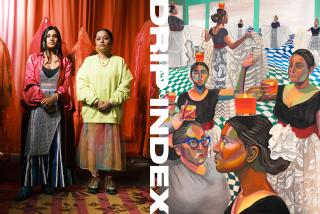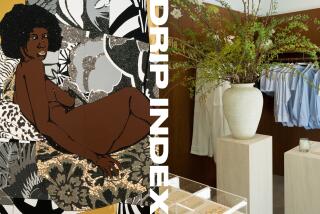How L.A.’s Islamic art shows might expand our ‘Middle East’ vision
- Share via
Too often the Middle East is reduced to just that: the “Middle East” — a blanket term defining a large swath of territory in Western Asia and North Africa, a news-hour shorthand for territorial conflicts and civil unrest. But “Middle East” does little to define the diversity of a region made up of nearly 20 countries, a dozen languages, myriad cultural traditions and several millennia of history.
A series of exhibitions scheduled to land in Los Angeles starting in September should help open some minds. The Los Angeles/Islam Arts Initiative (LA/IAI), led by the Department of Cultural Affairs, will bring together nearly 30 cultural institutions in the L.A. area to stage exhibitions and events that will tell the story of Islamic art around the world. This should offer some perspective on the culture of a region whose politics and traditions are often oversimplified, when they aren’t serving as a source of outright caricature.
“One of the things that we were talking about when we were planning this initiative was the huge role that Hollywood has in creating a picture of what is and isn’t Muslim,” says Amitis Motavelli, who is overseeing the program for DCA. “This image is spread internationally. So I think it behooves the city of L.A. to look at multiple views — not just that of constant victim or constant terrorist. We want to show the multiple perspectives that exist in any culture. It humanizes people.”
The initiative will consist of dozens of exhibitions, screenings, lectures and symposia covering topics as varied as decorative objects, contemporary art, folk traditions and architectural photography. The centerpiece of the series will be “Doris Duke’s Shangri La: Architecture, Landscape, and Islamic Art,” a traveling exhibition of the Islamic art and decorative objects collection amassed by tobacco heiress Doris Duke beginning in the 1930s. That show will be staged at the L.A. Municipal Art Gallery and is scheduled to open in late October.
“The collection is so interesting because it is high-low,” says Donald Albrecht, an independent curator from New York who helped organize the show. “She gathered objects from all over the world, from all different centuries. She mixes old vintage objects with modern tiles made in the same tradition.”
Throughout her life, Duke gathered all of these pieces, which included jewelry, mosaics and prayer niches, and put them on display at her home in Hawaii (which is open to the public and administered by the Doris Duke Foundation for Islamic Art).
The collection is not of museum-quality (a thorough academic examination of the art of a culture or period), but it is emblematic for the ways in which it shows the remarkable breadth of Islamic art. And it does say a lot about Duke, who chose to focus her collecting energies in a part of the world that weren’t necessarily in vogue at the time.
“She collected across time and she collected across geography,” says Tom Mellins, who co-curated the show with Albrecht. “There’s a gold jug that is from the first millennium BC. It’s only 7 1/2 inches high, very delicate, with an almost Modernist sensibility. But it tells you something about the range of her collection.”
It’s also an exhibition that should illuminate a thing or two about Southern California’s artistic and architectural traditions. Islamic motifs have long made their way into the design of resort hotels and atmospheric theaters in the United States. It is also omnipresent in the Spanish tiles (which bear Moorish and other Islamic influences) present in the many historic structures in Los Angeles, such as the Adamson House in Malibu.
Since the LA/IAI effort focuses on the art of the Islamic world, the exhibition won’t be entirely about the Middle East. Islam is well-represented in other parts of Asia, as well as Europe and the U.S. And, as a result, there will be events that explore everything from the presence of Islam in American hip-hop culture (at the William Grant Still Arts Center, opening Oct. 4) to East Asian calligraphic traditions (at the Japanese American Cultural Community Center, from Oct. 25).
But it’s safe to say that the Middle East serves as the initiative’s beating heart, since it is from this region that Islam, and its many cultural practices, originated. REDCAT, in downtown Los Angeles, will screen films by Iranian women (starting Oct. 27), and the USC Pacific Asia Museum in Pasadena will feature an exhibition on the folk tradition of Pakistani bus painting (also in October).
Moreover, the L.A. Municipal Art Gallery will be showing a companion exhibition to “Shangri-La: Imagined Cities,” which will feature the work of more than half a dozen contemporary artists from all over the world.
Taking a cue from Duke’s extensive travels, curator Rijin Sahakian is putting together an exhibition that brings together more than half a dozen contemporary artists exploring issues of mobility in their work.
“People might be forced to move from place to place,” says Sahakian. “Or people within a country will move from one place to the next for opportunity. Artists go to school in one city then move to another. A city like Marseilles can feel the reverberations of what is happening in the Middle East because it has a lot of Algerian immigrants. So I was interesting in looking at issues of time and mobility and how bodies traverse different geographies.”
The show will include the work of George Awde, who is known for photographing immigrant men in cities like Beirut, and Mariam Ghani, an Afghani American artist whose work explores cross-cultural themes. In this case, she will be showing work from her project “The Trespassers,” a video that explores the slippery nature of translation, produced in collaboration with translators who worked in the service of the U.S. military in Afghanistan.
Unfortunately, there seems to be one significant piece missing in the roster of LA/IAI events: the L.A. County Museum of Art. The museum has one of the best collections of Islamic art in the world and it will not be a part of the series. Principally, because the collection will be traveling through Latin America while much of the LA/IAI series takes place.
This is a bummer. It would have given the initiative a much stronger art-historical spine. The Doris Duke collection is fascinating, but it’s more about her, and the design of her home, than it is a profound investigation into the art of the Islamic world.
Moreover, the LA/IAI series of events lists the play “Persians,” by Aeschylus, at the Getty Villa, as one of its happenings. This is downright bizarre, since the play is a Greek tragedy — one that predates the Islamic era. (The Getty was staging the play regardless of the LA/IAI series but allowed for it to be included in the initiative’s list of events.)
Likewise, some of the smaller events in LA/IAI feel a bit kitchen sink, like the music nights dubbed “Discostan,” that will be held at Footsie’s, a popular hipster bar in Cypress Park.
Regardless, the series will hopefully provide plenty of food for thought. Islam and the Middle East are often lumped into a single abstract cultural lump. But within that are vast differences in topography, language, nationality, ethnicity, artistic and architectural output.
“There are so many specific contexts,” says Sahakian. “For example, there is a deeper relationship of exchange between Iraq and the U.S. than, say, between Iraq and Algeria. It’s important to note that this isn’t one kind of place or one kind of terrain.”
With conflicts boiling over in Syria and Iraq, and with major cultural centers going up in cities like Abu Dhabi, it couldn’t be a better time for us to begin to understand the differences.
“LA/IAI” begins Sept. 4 with productions of the Greek tragedy “Persians,” by Aeschylus, at the Getty Villa, 17985 Pacific Coast Highway, Pacific Palisades, getty.edu. “Shangri-La: Imagined Cities” opens Oct. 26 at the L.A. Municipal Art Gallery at Barnsdall Park, 4800 Hollwyood Blvd., East Hollywood, lamag.org. Rizzoli has a beautiful catalog (with photography by Tim Street-Porter) of the Doris Duke portion of the show. A full roster of LA/IAI events will soon go up on the LA/IAI website.
Find me on Twitter @cmonstah.
More to Read
The biggest entertainment stories
Get our big stories about Hollywood, film, television, music, arts, culture and more right in your inbox as soon as they publish.
You may occasionally receive promotional content from the Los Angeles Times.











